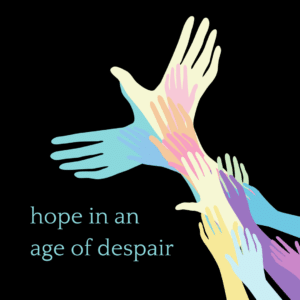
It is the stubborn commitment to believe in possibilities that we cannot yet see.
And in times of despair, we need hope more than ever.
But I’ve had so many conversations this week about hope; hope that seemed impossible to find, or naive to believe in.
Hope that lived slightly out of reach.
There was worry, what if I hope and things don’t turn out? What if I’m wrong? What if my heart breaks?
What if I’m seen as naïve or idealistic? What if people scoff?
There was despair; fear and pain pushing hope into the distance.
Refuge sought in cynicism and armour.
Guards at our heart to protect from disappointment.
The dull, bitter ache of apathy more tolerable than the sharp pain of life.
But I believe in the power of hope.
Not a naïve positive thinking, detached from the pain of the world.
Not an innocent longing, that knows nothing of struggle.
But a hope that is grounded in potential.
That knows there is a field with myriad possibilities; ones we may never see or touch but that nonetheless still exist.
I believe in a hope that is less feeling, and more practice.
So, if you’re in need of a little hope this week, I invite you to explore these practices.
1. Beauty-Making: The practice of finding or making beauty wherever we are.
Maybe it’s in the clouds, the sky, the birds or flowers. Maybe you can help make it through art, an act of kindness, a delicious meal. Maybe it’s a sunset or the lake at dusk.
Hope and beauty are close friends. Where can you find beauty today? How can you make it?
2. Imagine. Imagination is the lovechild of hope. If possibilities exist, what might they look like? What ‘third way’ can we find? Can we allow ourselves time to dream, play and create?
3. Grieve. Hope is not detached from reality; we cannot feel hope without the fullness of our emotions. And while hope often looks dark from the midst of grief, grief in an age of despair is a sign of our humanity. It is the consequence of our love, and to offer it ritual and honour is part of what makes hope possible.
4. Look backwards. We often think of hope as a forward looking thing – and it is. But sometimes we generate most by looking backwards.
Where in our lives has change seemed impossible? Where has it happened anyway?
Where throughout history might change have seemed impossible? Where has it happened anyway?
Who have you thought to be impossible of change? How might they have changed anyway?
Life is made of possibility.
5. Surrender. Part of our struggle with hope is our need to see the outcome. Our need for things to be a certain way. Our need to not be wrong, to know with certainty that things will turn out – often with a nice, neat arc and ending.
We confuse hope with control, hope with certainty, hope with knowing, hope with a fixed ending, hope with utopia, hope with relief, hope with the end of anxiety… each time missing what hope really is.
Because hope, at its most raw, is the willingness to live in a story that is not yet complete.
A story that we are not the only author of.
And a story that never really ends.
Laura x
